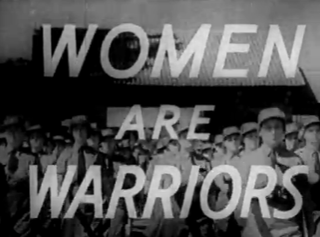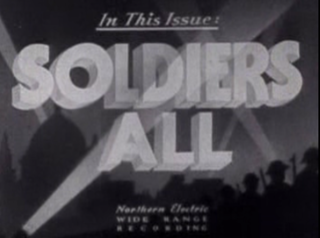On the Spot was the first television series made specifically for TV by the National Film Board of Canada, which aired on CBC Television for two seasons from 1953 to 1954. Each episode reported on a different aspect of life in Canada. The series was originated by Bernard Devlin.

Wasp Wings is a 42-minute 1945 Canadian documentary film made by the Royal Canadian Air Force (RCAF) Overseas Film Unit and the National Film Board of Canada (NFB). The film takes its name from the colourful markings known as invasion stripes that were painted on Supermarine Spitfire fighter aircraft on D-Day, making them look like "angry wasps".

Train Busters is a 13-minute 1943 Canadian documentary film, directed by Sydney Newman. The film was made by the Royal Canadian Air Force (RCAF) Overseas Film Unit and the National Film Board of Canada (NFB) as part of the NFB's Canada Carries On series. Train Busters depicts the Allied night bombing campaign over German-occupied Europe that was complemented by close air support missions flown by the RCAF targeting enemy trains.

Wings on Her Shoulder is a 10-minute 1943 Canadian documentary film, made by the National Film Board of Canada (NFB) as part of the NFB's The World in Action series. The film, directed by Jane Marsh, depicts the role of the Woman's Division in the Royal Canadian Air Force (RCAF) during the Second World War, who freed up men for flying duties.

Canada's Air Defence is a 33-minute 1957 Canadian documentary film produced by the National Film Board of Canada (NFB) for the Royal Canadian Air Force (RCAF). The film depicts the role of air defence over Canada and the United States by following the training and operational exercises of a RCAF squadron.

Birth of a Giant is a 29-minute 1957 Canadian documentary film, directed by Hugh O'Connor and produced by the National Film Board of Canada (NFB) for the Canadian Broadcasting Corporation (CBC) television series, Perspective. The film depicts the role of story of the conception, construction and testing of the Canadair Argus aircraft, designed as a maritime patrol and anti-submarine aircraft for the Royal Canadian Air Force (RCAF). The title is an acknowledgement, that at the time, the Argus was the largest aircraft ever built in Canada.

Transpacific Flight is a 1953 Canadian short documentary film, part of the On The Spot series made specifically for television, produced by the National Film Board of Canada (NFB). The documentary involved an account of a flight across the Pacific Ocean in 1953, based on first-person interviews of the flight crew.

The Aviators of Hudson Strait is a 1973 Canadian short documentary film produced by the National Film Board of Canada (NFB) for the Canadian Department of National Defence.

Routine Flight is a 1955 Canadian short documentary film produced by the National Film Board of Canada (NFB) as part of the On The Spot series made specifically for television. The documentary, directed by Gordon Burwash, involved an account of a visit to a Trans-Canada Air Lines (TCA) maintenance centre while it is involved in transitioning to a new type of airliner. Routine Flight is based on first-person interviews of the staff at the maintenance centre and flight crew on a test flight.

Target - Berlin is a 15-minute 1944 Canadian documentary film, made by the National Film Board of Canada (NFB) as part of the wartime Canada Carries On series. The film was produced by Raymond Spottiswoode and directed by Ernest Borneman, from a story by Leslie McFarlane, based on the industrial production of the Avro Lancaster in Canada, from initial production to the first example taking part in a raid on Berlin. The film's French version title was Objectif Berlin.

The Home Front is a 10-minute 1940 Canadian documentary film, made by the National Film Board of Canada (NFB) as part of the wartime Canada Carries On series. The film was produced and directed by Stanley Hawes. The film's French version title is La Femme et la Guerre.

Women Are Warriors is a 14-minute 1942 Canadian documentary film, made by the National Film Board of Canada (NFB) as part of the wartime Canada Carries On series, and dealt with women in war. The film was produced by Raymond Spottiswoode and directed by Jane Marsh. The film's French version title is Les Femmes dans la mêlée.

Portrait of Canada is a 10-minute 1959 Canadian documentary film, made by the National Film Board of Canada (NFB) as part of the postwar Canada Carries On series. The film, directed by Guy Glover, described the creation of the All Canadian Atlas. The film's French version title is L'Atlas du Canada.

Screaming Jets is an 11-minute 1951 Canadian documentary film, made by the National Film Board of Canada (NFB) as part of the postwar Canada Carries On series. The film, directed by Jack Olsen and produced by Sydney Newman, depicted the contemporary Canadian and international aircraft in production and on the drawing boards. The film's French version title is Avions à réaction.

Proudly She Marches is an 18-minute 1943 Canadian documentary film, made by the National Film Board of Canada (NFB) as part of the wartime Canada Carries On series. The film, directed by Jane Marsh and produced by Raymond Spottiswoode, described the work of Canadian women in uniform during the Second World War. The film's French version title is Carrières de femmes.

Inside Fighting Canada is an 11-minute 1942 Canadian documentary film, made by the National Film Board of Canada (NFB) as part of the wartime Canada Carries On series. The film, directed by Jane Marsh and produced by James Beveridge, was an account of the Canadian military during the Second World War. The film's French version title is Canada en guerre.

Neptune Mission is a 1958 30-minute Canadian short documentary film produced by the National Film Board of Canada (NFB) for the Canadian Broadcasting Corporation (CBC) television series, Perspective. The film documents the submarine-hunting mission of the RCAF Neptune aircraft on Canada's Atlantic coastline during the Cold War. Neptune Mission is produced by David Bairstow, and directed by Walford Hewitson.

Soldiers All is a 20-minute 1941 Canadian documentary film, made by the National Film Board of Canada as part of the wartime Canada Carries On series. The film was produced by Stuart Legg. Soldiers All describes the experiences in 1941 of soldiers, airmen and sailors in Great Britain and Canada during wartime. The film's French version title is Frères d'armes.

Squadron 992 is a 23-minute 1940 British propaganda film produced by the General Post Office GPO Film Unit of the Ministry of Information and re-distributed by the National Film Board of Canada (NFB) as part of their wartime Canada Carries On series. The film was directed by Harry Watt and produced by Alberto Cavalcanti. Squadron 992 describes the training and operations in 1940 of No. 992 Squadron RAF, a Royal Air Force (RAF) barrage balloon unit stationed in the United Kingdom. The film's French version title was Escadrille 992.

Air Cadets is a 15-minute 1944 Canadian documentary film, made by the National Film Board of Canada (NFB) as part of the wartime Canada Carries On series. The film describes the Air Cadet Movement in 1944 during the Second World War. Air Cadets was directed by Jane Marsh, who was also the writer and editor on the production. The film's French version title is Les Cadets de l'air.



















